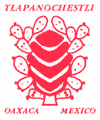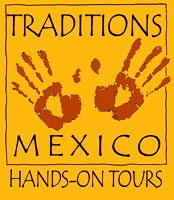|
Natural Dyes: Classes, Workshops and Demonstrations
The natural dyes are obtained from:
- Natural shades of wools
- Bujuco, a parasitic moss native to Oaxaca
- Campeich Wood, a tree native to Oaxaca
- Cochineall, produced in Oaxaca
- Indigo
- Marigold
- Madrone Bark
- Moss, a tree moss native to Oaxaca
- Muitle, a small shrub native to Oaxaca
- Pecan shells, leaves or bark
- Wild Tarragon, native to Oaxaca
The cochineal bug is a beetlelike insect and parasite that lives in a
symbiotic fashion with the nopal cacti (or prickly pear), feeding on the
abundant sap of the thick round leaves. It has the external appearance
of a white velvet-like mold.
The process of extracting the dye is very similar to that
of making tea. After being ground-down and added to water it's then heated
to extract the color and then combined with either alum or another mordant
which acts as a fixer. The resulting distinctive tones can range from
red to purple depending on the acidity or the alkalinity of the mixture.
Of notable interest, only the females have this red pigment, due to the
presence of carminic acid; the males only serve to fertilize the females.
The town of Nochixtlan in the state of Oaxaca was renowned for its abundant
cultivation and production of this insect which thrives specifically on
the Oaxacan species of nopal cactus(prickly pear). Nowadays the Tlapanochestli
centre in Santa Maria Coyotepec is the main location for production
and development of cochineal.



Natural Dyestuffs
To many people the most exciting thing about any piece of textile is
its colour, and certainly in studying hand-made textiles the development
and application of dyestuffs is one of the most interesting aspects. Until
the latter half of the nineteenth century, with the exception of a few
mineral colours, all dyes were vegetable or animal in origin. Colouring
matter was extracted from the roots and stems, leaves, berries and flowers
of various dye-plants, and from certain insects and shellfish by an elaborate
series of processes used, with little basic change, from hundreds of years
before the Christian era, through the Middle Ages, until the rationalization
of chemistry in the eighteenth century. These natural dyes, with very
few exceptions, are not substantive (that is to say they have very little
or no colouring power in themselves), but must be used in conjunction
with mordants - or 'drugs', as they were often called. Commonly, large
stocks of alum were handled by Mediterranean traders for many years. A
mordant, usually a metallic salt, has an affinity for both the colouring
matter and the fibre and in combining with the dye in the fibre it forms
an insoluble precipitate.
A brilliant scarlet dye had been known and used in Europe since ancient
times, obtained from the dried bodies of the pregnant females of the kermes
shield-louse, as well as the more expensive reds from the "purple"
Murex, obtained from several species of shellfish found in the Mediterranean.
In the sixteenth century when the Spaniards conquered Mexico they discovered
the Aztecs wearing materials dyed bright red and they immediately had
vast quantities of the dried cochineal insects, from which the dye was
obtained, shipped to Spain and other countries. The so-called cochineal
beetle is in fact another species of the shield-louse family which lives
on cactus plants. Cochineal was used to dye wool, silk, morocco leather
and, laterly, cotton, and quickly replaced kermes. Cochineal dye has a
powerful affinity for alum.
The Indigo plant is a sub-tropical bush about five feet high. At the time
of flowering, particularly if the buds were removed, the leaves, from
which the colouring matter was attained, yielded their highest percentage
if they were cut down close to the ground and immediately collected into
bundles and put to steep. The roots which were left very quickly started
to sprout again, giving a second and sometimes a third crop, but yielding
progressively weaker concentrations of colouring matter.
ON THE BLOOD OF THE PRICKLY PEAR
The color of cochineal is called nocheztli, which means blood of the
prickly pear. For some strains of these fruits are host to a certain worm,
called cochineal, whose blood is bright red. Such is the most refined
dye of this land. That which is already processed and formed into cakes
is called 'solid' or 'fine'; "this is sold in the markets to painters
and dye-masters," reported Fray Bernadino de Sahagun with regard
to this most eminent of pre-Hispanic dyes. At that time, dozens of communities
were expected to contribute five, twenty or forty bundles or sacks of
cochineal every eighty days. Barbo Dahlgren has calculated that the total
of 65 sacks, at 150 pounds each, could weigh 9750 pounds. These communities
were located in the Mixtec provinces of Tlachquaico, Tlaxiaco and Coaixtlahuaca,
in the upper Mixteca region, and in the Zapotec province of Coyoloapan
and Cuilapan, in the Valley of Oaxaca.
Since cochineal appears as a highly specialized tribute exacted from this
Mixtec/Zapotec zone, it would not be presumptuous to suggest that this
was the area in which the properties of the modest insect were originally
discovered, and its domestication and exploitation first worked out. As
a pest attacking certain species of prickly pear cactus, particularly
Opuntia and Nopalea, it requires constant attention and specially maintained
breeding grounds.
The Spaniards did not find as much gold as they had hoped for in Oaxaca,
but they were quick to turn cochineal into an alternative source of wealth.
By 1660, the export of this dye to Europe had become a leading economic
earner for New Spain, second only to silver, and was to retain an important
place throughout the colonial period.
The high quality of the carmine red produced by Oaxaca stock overshadowed
all the other red dyes in the Old World, including Rubia tintoria and
even Persian Kermes, (also derived from an insect). Unusually versatile,
cochineal can adopt shades from orange to violet, according to the mordents,
fixatives and toners applied. Its effect on wool and silk - both protein
fibers - can be spectacular; but the great challenge remains to discover
the formula elaborated by ancient Oaxacans to dye cotton with it.
The cultivation of cochineal was introduced by the Spaniards to various
parts of New Spain, as well as to Peru, Guatemala and the Canary Islands.
Around 1821, Guatemala became a serious competitor in its exportation.
Cochineal's final knell in Mexico was sounded in 1850, with the invention
of chemical dyes. Today, Peru supplies sixty percent of the world market.
Demand has risen in the food and cosmetics industries, due to the carcinogenic
factor recently identified in synthetic red colorants. Cochineal production
was saved from extinction in Mexico by the efforts of engineer Ignacio
de Rio, who has concentrated on the Tlaponochetzli
nursery in Santa Maria Coyotepec, Oaxaca. However, output is low and reserved
for national consumption.
 
Demetrio participated in a 3-day workshop with Ignacio
del Rio
THE INIGMA OF MAYA BLUE AND INDIGO
Evidence of the pre-Hispanic use of indigo, known in Nahuatl as xiuhquilitl
or "blue herb", has been considerably reinforced during the
last decade. Maya Blue, a turquoise pigment, is now thought to consist
almost certainly of indigo extract blended with clay called atapulguita.
It is found on murals as well as vessels, and was used to paint textiles
in places such as La Garraga and Chiptic, in Chiapas. There are also indications
of its presence on fabrics found in caves at Ejutla(Oaxaca), as well as
in La Garrafa, where an antique child's huipil was discovered.

We know that hundreds of Indigoferas, or indigo-bearing plant species,
exist throughout the world, especially in southern India and North Africa,
the home of Indigofera tinctoria. Researcher Dean Arnold contends that
the American strains originated in, and spread from, an area between Guerrero
and Michoacan, including the State of Mexico, Morelos and Oaxaca; later
they reached Central and South America. Among the fifty-odd native American
species the most significant are Indigofera suffruticosa and Indigofera
guatemalensis. The task of identification and historical accuracy are
complicated by the fact that soon after the Conquest, the Spaniards introduced
Indigofera tinctoria, which displaced or decimated the native strains.
The cultivation of the imported plant was encouraged by Spanish landowners,
and as was the case with other crops, formed part of tribute. Ever since
the pre-Hispanic period, a commercial corridor existed from Oaxaca to
Guatemala; it was accessed through the coastal estuaries. Later, merchants
would take mule-trains laden with huipils, rolls of sackcloth and ayate
ponchos, returning with cargoes of Guatemalan cocoa and indigo. In Mexico,
the cultivation of indigo only survived in Niltepec, on the Isthmus of
Tehuantepec; in recent years, efforts have been made to revive it.
Marta Turok, Artes de Mexico, "Textiles de Oaxaca", Número
35, 1996, Translated by Lorna Scott Fox, Transcribed onto the web without
permission (pending)
Other notes:
Natural dyes are very laborious to process, not only with respect to
the colors but also how well the mordant or fixer is mixed in. Usually
lime juice, or sometimes the leaves and bark of a tropical tree called
bejuco are used.
Natural dyes went out of style in the 1920's when chemical dyes were
introduced. However, due to the beautiful subtle tones that no chemical
can reproduce, natural dyes are now well and truly back in vogue. There
is a large variety of plant, animal and mineral sources available today.
Among these are lichen, twigs, berries, flowers, pecan bark, walnut husks(tans
and browns), huisache seed husks(black), alfalfa and purul leaves(both
give green), and "guaje" husks(reddish brown). The brown dye
that comes from pecan shells is also made this way.
"This red we get from the cochineal comes from a little insect that
lives on the nopal cactus. The color of most natural dyes is soft, but
by adding lime juice to the cochineal, we can get a brilliant red. We
use three different plants to get the yellows, and each one gives four
different shades from successive dyes. We use several different parts
of the pecan tree to get our browns, including the roots, the leaves,
and the shells."
Using secret combinations, recipes and mixtures the weavers can conjure
up an astounding array of colours and textures. These colors are the deep,
vibrant tones of nature and are very long-lasting.

Traditions Mexico
Hands-on Workshops with Demetrio can be organised in conjunction with Eric Mindling.
" Murex, Cochineal, and Indigo! Oaxaca Natural Dye Workshop"
March 10 - 19, 2011.
More info about these in-depth group workshops from their website.
Testimonials:
Dec 2003
" Thank you for the time you took to show us how you make the natural
dyes. The rugs you make are beautiful. Please let us know when you come
to Chicago so we can see you. "
Pat Janezich, Dennis Talbott, Chicago, Il. (patjan@worldnet.att.net)
Jan 2004
" Your kind hospitality and knowledge of natural dyes is warming.
Thank you so much! Come Visit! "
JB and Lisa Rogers, Evergreen, Colorado (jbaass@aol.com)
Also, Rebecca Severeide from Portland, Oregon leads all-inclusive tour groups to Oaxaca. For more details see VacationsToDyeFor.com
If you are interested in learning more from Demetrio, he offers classes, workshops
and demonstrations.
|
![]()
![]()
![]()









